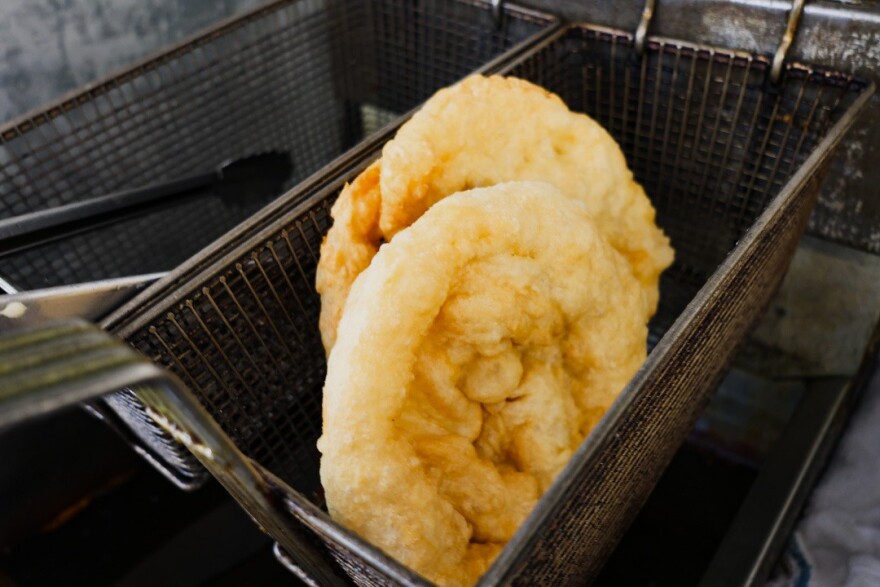Tanya and Wasinade Raphael are the mother-daughter team behind Raphael Foods. You’ll find their food truck drawing long lines at powwows and other tribal events across Northern Michigan. Most of their dishes are built on hot, pillowy fry bread – a Native American flat bread with a complex history.
“I can go through over 200 pounds of flour at a powwow,” Tanya said. “And that's a two-day powwow. We get into the three days and it's a little bit more.”
Life in Peshawbestown
When they’re not out on the circuit, the Raphaels cook and live in Peshawbestown, a small community just north of Suttons Bay. The town sits on part of the Grand Traverse Band Reservation.
The Raphael Foods truck is usually parked on the town’s main road, across the street from a Catholic parish and the Grand Traverse Band Tribal Court.
Tanya grew up in Grand Rapids, but knew she wanted to raise her children somewhere quieter. When she moved to Northern Michigan in the early 1990s, the transition wasn’t easy.
“At first, when I moved up here, I'd have anxiety attacks,” Tanya said, “just because I wasn't used to the quietness.”
But now, she says, she’d never return to city life. She’s grateful for Peshawbestown’s tight-knit community, where children can wander freely and neighbors look after one another.
“This is always gonna be home,” Wasinade said. “It’s home if I leave or not. I’ll always come back."
The Star of the Menu
Fry bread is the star of the menu at Raphael Foods.
It’s a simple flat bread made with flour, salt, baking powder, and water, and fried until golden and puffy. It’s crispy on the outside and soft on the inside, sort of like a fluffier elephant ear. The dish can be eaten simply with powdered sugar and honey, or it can become the base layer for more complicated dishes.
Fry bread is a food born of hardship and persecution. As the United States government forced Indigenous Americans onto reservations, Native families needed to find new ways to feed themselves with the limited staple commodities they were given.
“Flour was one of those commodities,” Tanya said, “and the women made food out of whatever they had.”

Even though fry bread was not originally a traditional dish, it is now common in homes, as well as at cultural and ceremonial events.
Everyone’s fry bread is a little different. Tanya’s recipe includes baking powder and now yeast, which she started adding after watching her husband’s cousin, Monica, make her own fry bread.
“You can also tell whose is whose,” Tanya said. “You see it and say, ‘Oh, yep, that's Monica's bread,’ or ‘No, that's Tanya's bread.’”
Raphael Foods serves pretty much every fry bread-based dish imaginable. There’s a burger on fry bread, Spam on fry bread, blanket dogs (hot dogs deep fried in fry bread dough), and a powwow favorite: the fry bread taco, also known as the Indian taco.
The Indian taco starts with the fry bread. On top, a heaping serving of taco meat and beans, with cheese, lettuce, and tomatoes (and if you’d like: jalapeños, onion, and sour cream).

“It's not your average taco,” Wasinade said with a laugh. “So when people actually come to the food truck, they think it's like a hands-on taco that you can eat… but it's definitely a fork and knife situation.”
“They’ll say, ‘Oh, wow, we didn't know it was that big,’” Tanya added. “And we’ll give it to them, and I’ll tell them ‘Good luck!’”
The Recipe
Fry bread starts with the dough. The current Raphael recipe is a mix of flour, water, sugar, baking powder, and yeast. The dough is parceled into small balls that are stretched out into a disk, and then popped into the hot oil.
“You can usually start seeing it brown on your edges,” Tanya said, standing over a bubbling fryer inside the food truck. “Then, it's time to flip it.”
The fry bread comes about 8 inches in diameter and about an inch thick.
When serving the fry bread as part of an Indian taco, Tanya likes to pair the dish with a side of her special corn soup.
The corn is boiled in wood ash, and then cleaned thoroughly and dried before cooking. The recipe comes Uncle Buddy, who used to make corn soup for the entire community. As Uncle Buddy has gotten older, Tanya has taken up responsibility for the soup – not just making it, but preserving the recipe. She even tracked down the same farmer where Uncle Buddy bought his corn.
“I wanted to continue the tradition of how he did it,” Tanya said. “Everything about what he did, I wanted to do it the same.”
Uncle Buddy isn’t leaving that to chance.
“He’s my favorite critic,” Tanya said. “He will call me and tell me whether I'm missing something or if I need to do something different.”
Luckily for Uncle Buddy, the recipe seems to be in good hands.
“He just called me the other day,” Tanya said, “and told me that I finally have it.”
Support for arts and culture coverage is supported in part by the Michigan Arts & Culture Council.














